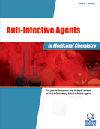- Home
- A-Z Publications
- Anti-Infective Agents in Medicinal Chemistry (Formerly Current Medicinal Chemistry - Anti-Infective Agents)
- Previous Issues
- Volume 8, Issue 3, 2009
Anti-Infective Agents in Medicinal Chemistry (Formerly Current Medicinal Chemistry - Anti-Infective Agents) - Volume 8, Issue 3, 2009
Volume 8, Issue 3, 2009
-
-
Antiviral Sesqui-, Di- and Sesterterpenes
More LessAuthors: T. Rezanka, L. Siristova and K. SiglerTerpenoids, biosynthetically related ubiquitous compounds found in virtually all living organisms from marine invertebrates to blooming plants, are derived from the same precursor but their structures and biological and/or pharmacological activities are widely different. Our review concerns terpenoid compounds with antiviral activities, from the simplest sesquiterpenes to diterpenes and sesterterpenes. They include commer Read More
-
-
-
Sterols and Triterpenoids with Antiviral Activity
More LessAuthors: T. Rezanka, L. Siristova and K. SiglerTerpenoid compounds of natural origin with antiviral activities, namely triterpenes and steroids, include compounds with potential future medical use as well as substances in different stages of clinical research and testing. These natural compounds have often been synthetically modified, the modification including both changes in the basic structure or mere substituent modifications.
-
-
-
Plant Natural Products as a Potential Source for Antibacterial Agents: Recent Trends
More LessAuthors: M. Shahid, A. Shahzad, F. Sobia, A. Sahai, T. Tripathi, A. Singh, H. M. Khan and UmeshPasteur and Joubert, in 1877, were among the first to recognize the potential of microbial products as therapeutic agents and demonstrated that common microorganisms could inhibit the growth of Anthrax bacilli. However, the milestone in the field of antimicrobial agents was the advent of penicillin, in 1928, by Alexander Fleming from a strain of the mold Penicillium. Since then, the fungi and higher plants have been searche Read More
-
-
-
Malaria and Leishmaniasis: Current Status of Chemotherapy, New Leads and Targets for Drug Discovery
More LessAuthors: Richa Pathak and Sanjay BatraThe mounting incidences of drug resistance of the unicellular eukaryotes along with insecticide- resistant vectors are the foremost factors contributing towards the amplified prevalence of tropical diseases in underdeveloped and developing countries. Malaria and leishmaniasis are two most significant parasitic diseases endemic in these regions and result in high rates of mortality and pose an additional socio- economic Read More
-
-
-
Interaction between Phenols and Bovine Serum Albumin
More LessAuthors: Yuanzhi Song, Jimin Xie, Yunlong Wu, Min Chen, Ganqing Zhao, Xiaomeng Lv, Huoming Shu and Songtao ChenThe interactions between bovine serum albumin and phenols have been studied by cyclic voltammetry (CV). The interaction divides into specific and non-specific binding sites, and mainly ascribes to the electronic force. One specific binding site between bovine serum albumin and p-aminophenol (p-AP) as well as p-quinonimine (p-AQ) is obtained. Both the specific binding number of p-AP and p-AQ binding bovine seru Read More
-
-
-
Current Status of Imaging Infections with Radiolabeled Anti-Infective Agents
More LessInfection specific radiopharmaceuticals can be used for diagnosis, decision-making in therapy and treatment follow-up. Research has been ongoing to develop infection specific markers since clinically used tracers cannot discriminate between infection and inflammation. A specific radiopharmaceutical for infection imaging should satisfy the following criteria: high and specific uptake at the infection site, rapid infecti Read More
-
Most Read This Month
Article
content/journals/aiamc
Journal
10
5
false
en


